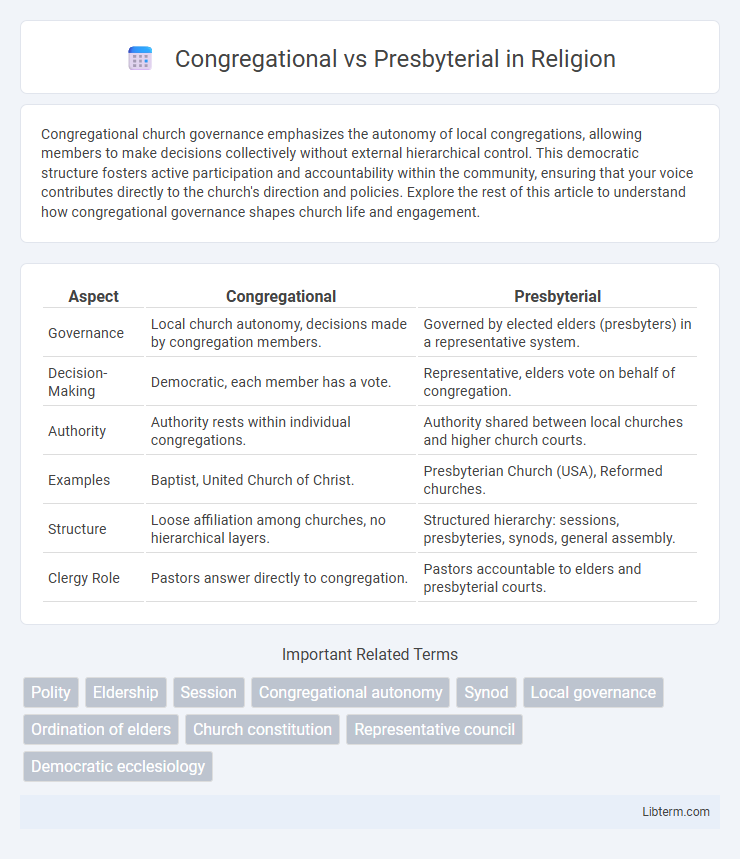Congregational church governance emphasizes the autonomy of local congregations, allowing members to make decisions collectively without external hierarchical control. This democratic structure fosters active participation and accountability within the community, ensuring that your voice contributes directly to the church's direction and policies. Explore the rest of this article to understand how congregational governance shapes church life and engagement.
Table of Comparison
| Aspect | Congregational | Presbyterial |
|---|---|---|
| Governance | Local church autonomy, decisions made by congregation members. | Governed by elected elders (presbyters) in a representative system. |
| Decision-Making | Democratic, each member has a vote. | Representative, elders vote on behalf of congregation. |
| Authority | Authority rests within individual congregations. | Authority shared between local churches and higher church courts. |
| Examples | Baptist, United Church of Christ. | Presbyterian Church (USA), Reformed churches. |
| Structure | Loose affiliation among churches, no hierarchical layers. | Structured hierarchy: sessions, presbyteries, synods, general assembly. |
| Clergy Role | Pastors answer directly to congregation. | Pastors accountable to elders and presbyterial courts. |
Understanding Church Governance Structures
Congregational church governance emphasizes local autonomy, granting each congregation authority to make decisions independently without external control, reflecting a democratic model where members elect leaders and determine policies. Presbyterial governance operates through a system of representative assemblies, with local churches governed by elders who participate in regional presbyteries that oversee doctrine, discipline, and church order. Understanding these structures reveals how authority is distributed either horizontally in congregational models or vertically through hierarchical presbyterial councils, impacting church unity, decision-making, and accountability.
Defining Congregational Polity
Congregational polity is defined by the autonomous governance of each local church, where decisions are made democratically by the congregation members without external hierarchical control. This system prioritizes the authority of the local assembly in matters of doctrine, leadership selection, and church discipline, contrasting with presbyterial polity which involves governance by a body of elders or presbyters across multiple churches. Congregational churches emphasize individual church independence, enabling members to directly influence church direction and practices.
Principles of Presbyterial Governance
Presbyterial governance is grounded in a representative system where authority is distributed among elected elders, emphasizing collective decision-making and accountability within a structured hierarchy. This model upholds the principle of connectionalism, linking local congregations through presbyteries and synods to maintain doctrinal unity and mutual oversight. The emphasis on shared leadership contrasts with congregational governance, where authority rests primarily within individual congregations without higher ecclesiastical control.
Historical Origins of Congregationalism
Congregationalism originated in the early 17th century within the English Puritan movement, emphasizing the autonomy of each local congregation in church governance. This system rejected hierarchical structures, contrasting with Presbyterianism, which emerged from the Reformation in Scotland and advocated for a graded church government led by assemblies of elders. The historical roots of Congregationalism highlight its foundation in dissent from Anglican episcopal authority and its commitment to independent, self-governing local churches.
Development of Presbyterianism
The development of Presbyterianism centers on a governance system characterized by representative assemblies called presbyteries, which consist of elected elders from local congregations, ensuring collective decision-making. This structure contrasts with Congregationalism, where each church operates independently under the authority of its members, emphasizing local autonomy. Presbyterianism's evolution emphasized a balance of authority between local churches and higher ecclesiastical bodies, promoting unity and doctrinal consistency across regions.
Key Differences Between Congregational and Presbyterial Systems
Congregational systems grant full autonomy to each local church, allowing members to make decisions independently without external authority, while Presbyterial systems feature a hierarchical structure where elected elders govern multiple churches collectively. Congregational governance emphasizes local control and democratic participation of the congregation, whereas Presbyterial governance distributes power through a series of representative councils, such as sessions, presbyteries, and synods. The difference lies in decision-making processes, with congregationalism favoring individual church authority and presbyterianism relying on organized, tiered leadership for accountability and unity.
Leadership Roles in Congregational Churches
Leadership roles in congregational churches are characterized by a decentralized structure where authority resides primarily with the local congregation itself, emphasizing democratic decision-making. Key leaders often include the pastor and elected lay members who serve on boards or committees, accountable directly to the congregation rather than a higher ecclesiastical hierarchy. This contrasts with presbyterian churches, where leadership is organized through a system of elders and higher governing bodies such as presbyteries and synods.
Leadership Hierarchies in Presbyterian Churches
Presbyterian churches feature a hierarchical leadership structure centered around elected elders, known as presbyters, who govern at multiple levels: the local session, regional presbytery, and national/general assembly. This representative system distributes authority across elders and ministers, ensuring collective decision-making rather than concentrated individual power. Unlike congregational churches, where authority rests primarily with the local congregation, Presbyterian leadership emphasizes connected oversight and accountability within the broader church network.
Impacts on Decision-Making and Authority
Congregational church governance grants decision-making authority directly to the local congregation, fostering a democratic process where members vote on key issues, leading to greater local autonomy and responsiveness. Presbyterial governance, structured around a hierarchy of elected elders and representative assemblies, centralizes authority and ensures doctrinal consistency across multiple congregations through collective decision-making. These differing structures impact organizational agility, with congregational models enabling swift local decisions while presbyterial systems provide broader oversight and accountability.
Choosing the Right Governance Model for Your Church
Selecting between Congregational and Presbyterial governance models hinges on your church's desired decision-making structure and accountability level. Congregational governance empowers local members with autonomous control over church affairs, fostering direct participation and community consensus. Presbyterial governance introduces a hierarchical framework where elected elders oversee multiple congregations, ensuring doctrinal consistency and shared leadership across churches.
Congregational Infographic

 libterm.com
libterm.com